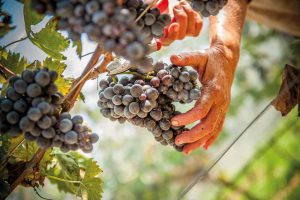North Macedonia is a small wine country with a big history. It’s tucked away among the mountains of the Balkan Peninsula and, as yet, has not crossed the radar of many wine buyers or tourists. But visitors to this off-the-beaten-track country can be certain of a warm welcome – and of finding exciting wines to discover.
In the endless search for the next wine story, North Macedonia has a lot to offer. It lies at the crossroads where East meets West, and its history has been shaped by Roman, Byzantine, Slavic and Turkish influences. Grape-growing has a long history in this region, with Neolithic evidence of grape remains, while both Philip II of Macedon and his son Alexander the Great were renowned drinkers of the local wine. Alexander used to give these wines to his soldiers to celebrate victories or to commiserate defeats.
The vineyards are beautiful, with bountiful wildlife – butterflies, birds, lizards and even tortoises wander among the vines, surrounded by dramatic towering mountains. The country’s beauty is recognised in its three national parks and its UNESCO World Heritage-listed Lake Ohrid, one of the world’s oldest lakes. The climate is generally warm and sunny, with 270 days of sunshine a year. It’s also a meeting point for climate zones: influences from the Mediterranean meet a Continental climate, moderated by mountain breezes.
What is North Macedonia today used to be the powerhouse of Yugoslavian wine until the breakup of the country in the early 1990s. The first private family-owned winery, Bovin, was founded in 1998, and the trend toward privately owned wineries has continued since then, bringing about a number of improvements in winemaking.

Wine is North Macedonia’s second-largest agricultural export and over the last ten years the industry has seen a huge change, with the focus shifting from bulk production to bottled wine, and an emphasis on quality. There have also been positive changes in wine culture and consumer habits in the domestic market, and in promoting awareness of the country’s wine internationally.
At the heart of Macedonian wine is the red grape Vranec, whose name translates as black stallion. It is a powerful, inky, dark grape, richer in colour and tannin than Cabernet Sauvignon. The variety is so important that it has its own annual day of celebration every October.
Vranec accounts for 10,800ha of North Macedonia’s 28,000ha of vines. The grape, which originates from what is now Montenegro, was planted here in the 1950s and found an ideal home in these sun-drenched vineyards. Its heartland is the central Vardar River Valley, where around 87% of the country’s grapevines are grown.
Vranac tends to give powerful, deep-coloured wines with plenty of structure and generous alcohol balanced by freshness and juicy fruit. Varietal characters may be notes of black or red cherry, blueberry, raspberry and blackberry. It shows distinctly different characteristics depending on where it’s grown. It also allows winemakers lots of choice – to pick earlier and vinify in stainless steel to show its fresher, juicy style, or to pick later and age in oak for depth, layered complexity and ageing potential. There are even versions made from super-concentrated raisined grapes that are almost Amarone-like, with a local twist.
For now it will take a determined wine drinker to hunt down some of these amazing wines, although it’s a search that will repay the effort. In the UK, very good wines from Stobi, Tikveš, Puklavec Family Wines and the boutique Chateau Kamnik are available. Readers in the US and Canada can find these wines as well as Bovin, Dalvina, Popova Kula and more.
An old proverb in the region says,
“If you want to get to know a nation well, sit at their table and drink their wine.”
There is no better way to explore North Macedonia than to enjoy its wines. Cheers.

Discover more and connect:
Wines of Macedonia YouTube channel
Facebook @WinesofMacedonia
Instagram @wines.of.macedonia







